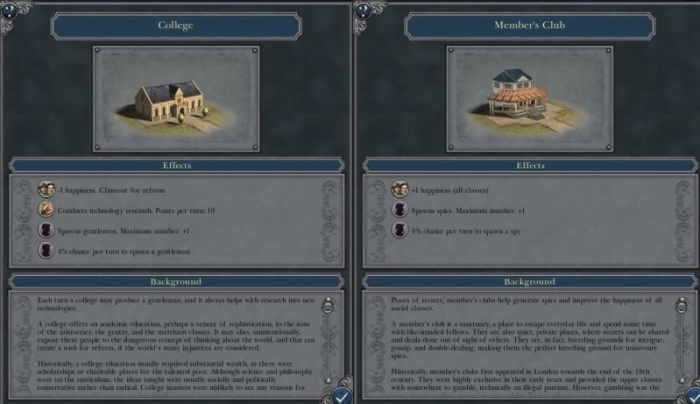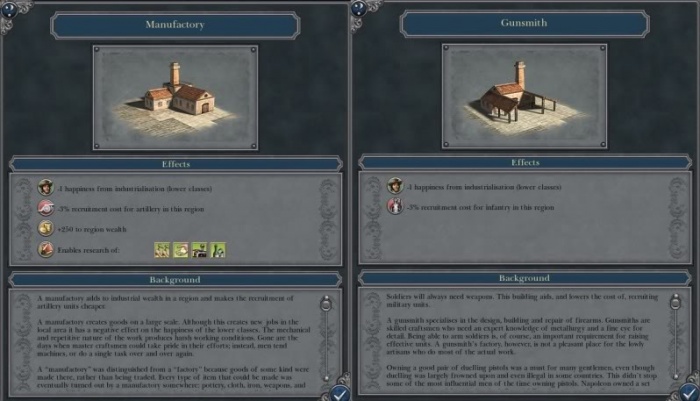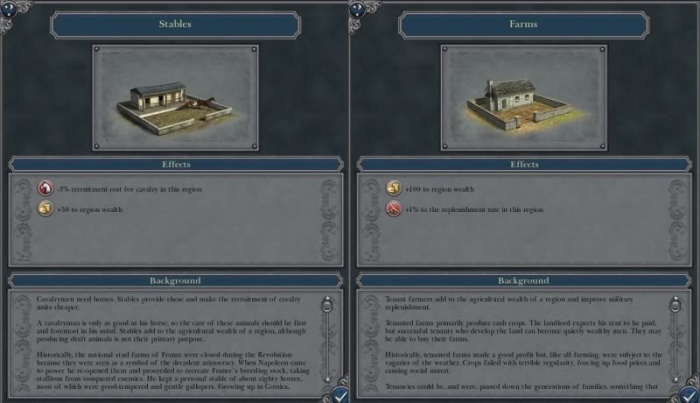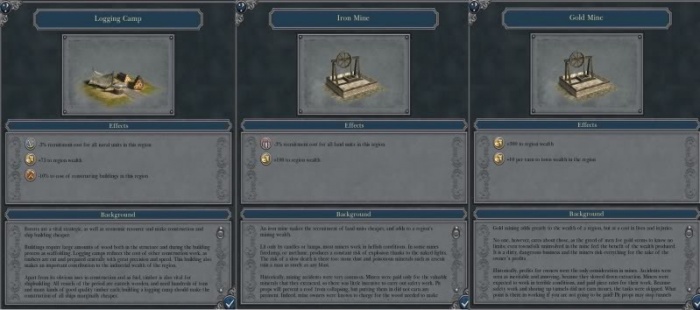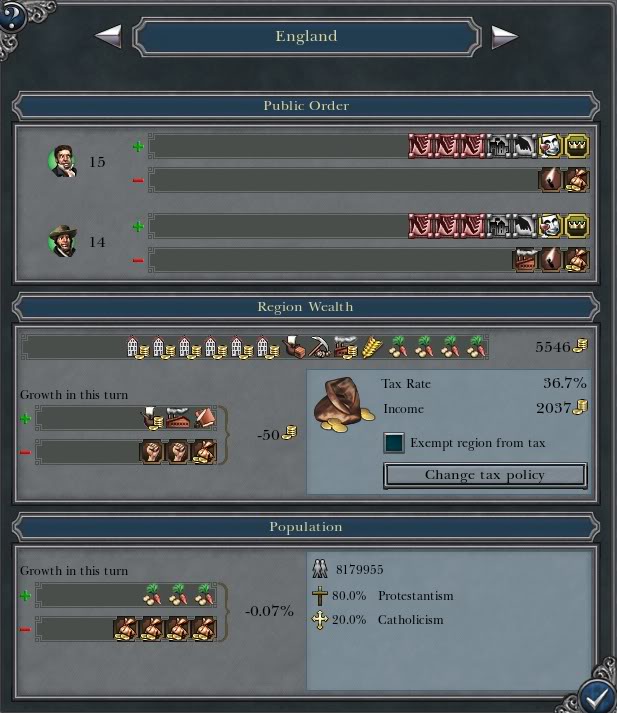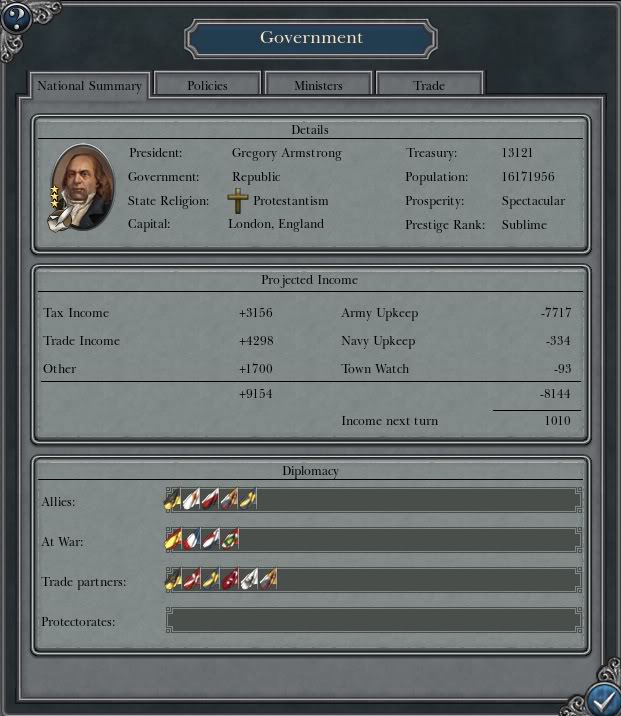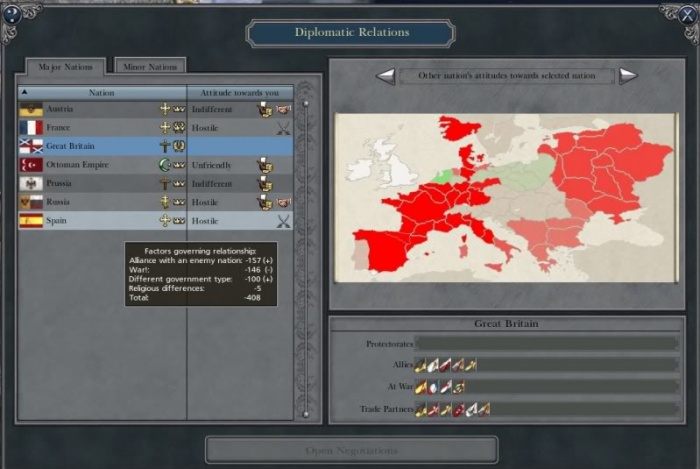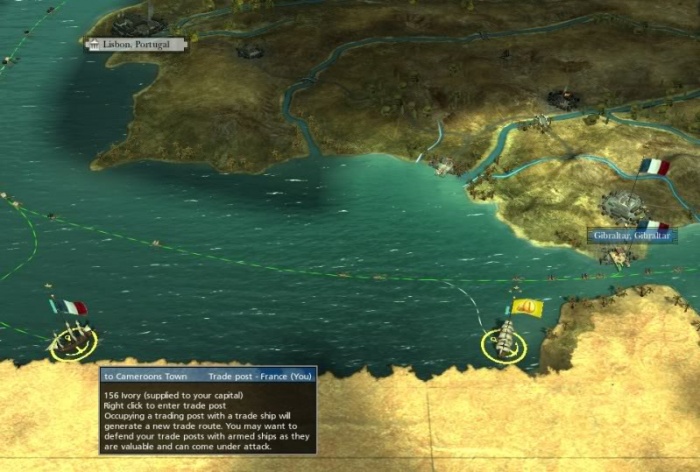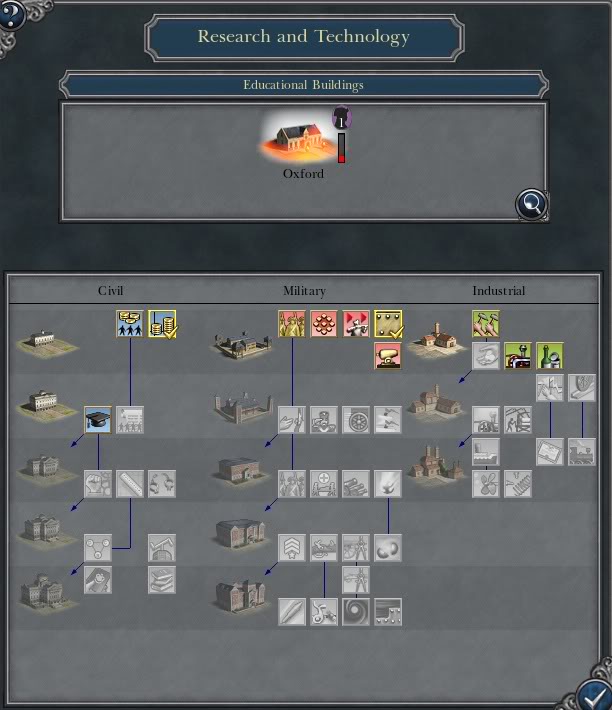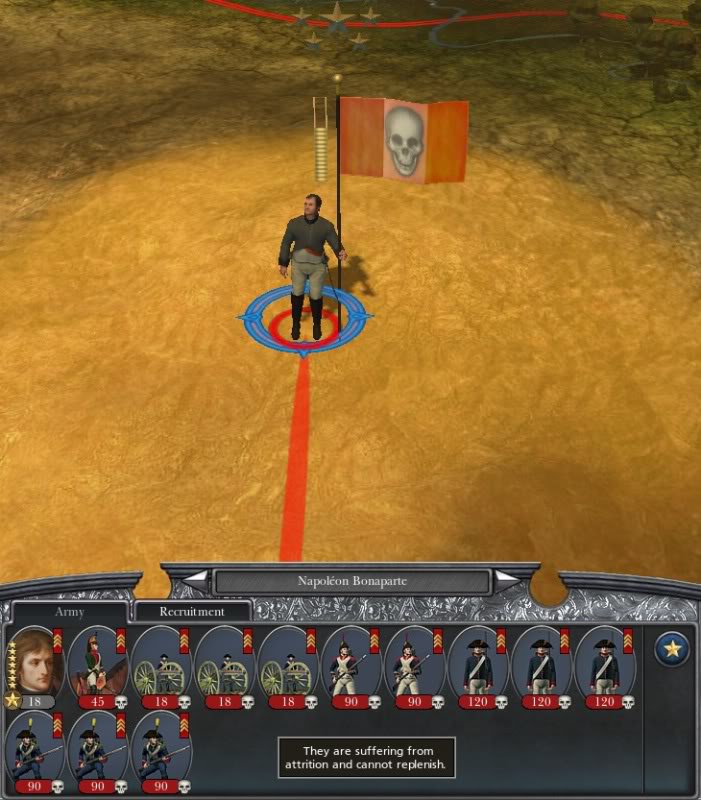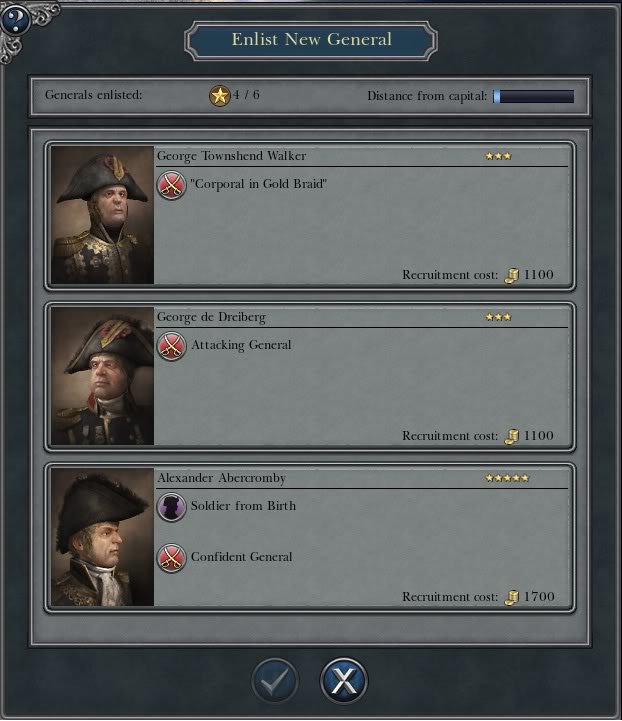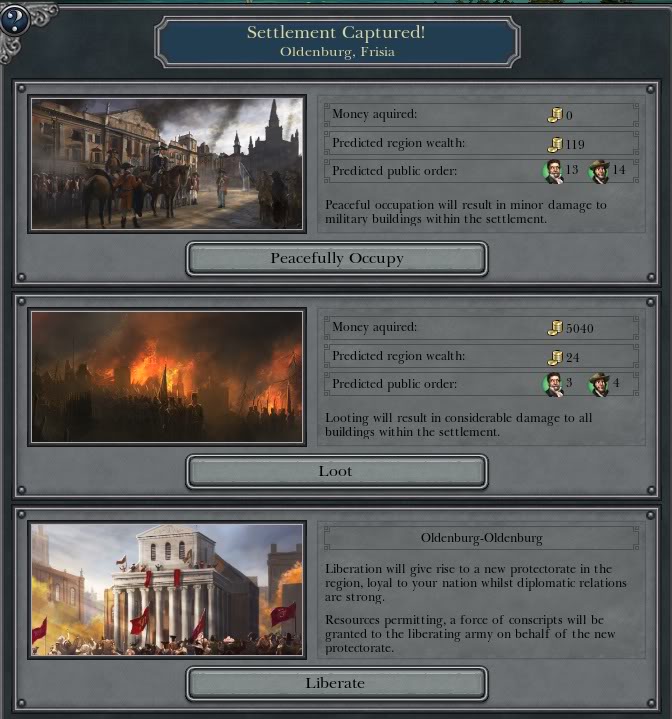Spraetter's Guide to Napoleon: Total War (NTW community guide)
Author: Spraetter (Originally posted 10 March 2010)
First of all I want to say that I've been having a blast with Napoleon: Total War. If it wasn't for the somewhat small scale and the lesser degree of variation and choices in your campaign, I'd say it was the best Total War game yet.
This time around there are much fewer questions to be answered than there were with Empire, seeing as N:TW is identical to E:TW in most of it's mechanics. If you're fuzzy about anything that's not covered in this guide it's probably covered in my guide to E:TW. As there is not nearly as much that needs explanation and clarification in N:TW, this guide will not be quite as massive as the E:TW one.
With all that said, let's get to it. I hope you enjoy it and can benefit from it in some way!
Contents |
Towns And Buildings On the Campaign Map
A lot has changed when it comes to the towns out on the campaign map. There are now three main types of towns; intellectual centres, industrial centres and commercial centres. Each town type has two kinds of buildings available to it, but you can only build one of them in a single town, so you have to choose. There are other places on the campaign map where you can construct buildings other than towns. These are pastures, farms, logging camps and mines. These sites only have one kind of building you can construct on them.
One big change to towns from E:TW is the different meaning town wealth has now. Each town's wealth is determined by the building in it. They are no longer "poor" or "wealthy" as in E:TW, and all towns have an equal productivity. The region's wealth is the sum of all your towns' wealth coupled with wealth from ports, mines etc.
Intellectual Centres
In your intellectual centres you can either build colleges or member's clubs.
A college can conduct research for you and will spawn gentlemen. They work more or less the same way now as they did in E:TW. The member's club boosts happiness in the region and spawns spies, making it very similar to E:TW's coaching inns.
Industrial Centres
In your industrial centres you can build either a manufactory or a gunsmith.
The manufactory makes artillery cheaper to recruit in the region it's built in, as well as adding a substantial amount to the region's wealth. The gunsmith reduces the cost for infantry recruited in the region. At first glance the gunsmith may seem vastly inferior, but the higher levels of this building are quite powerful if placed in a region you use as your main recruiting hub, and it can save you a lot of money.
Commercial Centres
In your commercial centres you can either build a market or a supply post.
The market is a pretty straight forward building, it adds region wealth and increases region wealth growth. The higher levels of the market building (the merchant and banking houses) are quite powerful and can do much to boost your economic growth.
The supply post and it's upgrades only do one thing: increase the rate at which your troops replenish. They are therefore best placed in frontline regions where you know that you'll have to replenish casualties fast. I don't find these buildings to be that useful. To see a worthwhile effect you have to upgrade it to the second or third level, and even then you rarely need the bonus in replenishment. I generally prefer to build the market chain of buildings since their economic boosts are quite large. Given how the replenishment system works, the supply post should only be built in isolated and surrounded regions that are far from your other regions and under constant threat of attack. The replenishment feature is a new feature in N:TW and will be covered in the "Armies And Navies" section.
Pastures, Farms, Logging Camps and Mines
These buildings differ from your towns in that they only have one building option available to them.
Stables will reduce the cost for recruiting cavalry in their region, as well as adding to a region's wealth. Farms increase replenishment rate and add to region wealth.
The logging camp is interesting, it reduces the cost for recruiting naval units, adds to region wealth and significantly reduces the cost for constructing buildings in the regions where it's located. At the first level this discount is at 10%, at the second it's at 12% and at the third it's at a whopping 15%. This makes the logging camp very nice to have in regions where you know that you'll construct a lot of buildings, for example in your home region. Most high-tier buildings can cost upwards of 10,000 gold to build, making a 10%-15% pretty substantial. I estimate that my logging camp in France in my French campaign saved me upwards of 20,000 gold.
There are two kinds of mines, iron mines and gold mines. The iron mine will add to region wealth as well as making all land units cheaper in it's region. The gold mine will add to region wealth and region wealth growth.
Regional Capitals
Regional capitals are the large cities. You attack and capture these to capture it's respective region.
The number of building slots in the regional capitals varies greatly and can be any number from one to six. If a regional capital has less than six slots, you are given the option as to what buildings you want to construct in it. You can choose from a government building that increases tax revenue and repression, a barrack building that can train infantry, an artillery building that can train artillery and a theatre building that raises the happiness in the region. All of these buildings allow the recruitment of militia, so regardless of which one you pick you can always train militia to control unrest and defend the city from attack. Most cities also has a slot for the construction of fort defenses.
The regional capital screen is very much like it's counterpart in E:TW.
This screen gives you a breakdown of everything you need to know about that region.
The "Public Order" section is pretty self-explanatory. It lists the public order in the region as well as what affects it.
The "Region Wealth" section lists the region's wealth and wealth growth as well as what influences these numbers. If you hover your mouse over the "Tax Rate" percentage it will show you why your tax rate is set to the number shown (in this case 36.7%). The amount of income you gain from a region is determined by the tax rate and the region wealth. In this case, England has a wealth of 5546 and a tax rate of 36.7%, resulting in an income of 2037 each turn. Region wealth growth is the number by which the region's wealth grows each turn. It's important to keep this number positive, otherwise you will make less money each turn.
The "Population" section of this screen is more or less useless. You can not convert people to another religion in N:TW, given the short time frame of the campaign. Unlike in E:TW, there are no additional towns for you to "grow", so population growth rate is not something you need to worry about. Population is still tied to the town watch cost for a particular region, however. That base value is .03 per citizen and is modified ( some percentage of the total cost) based on difficulty level. So heavily populated regions will be substantially more expensive to police sans garrison.
Agents
There are two kinds of agents in N:TW; spies and gentlemen. There are no priests as there is no religious conversion given the short time frame of the campaign.
Spies have a variety of uses. They have a long line-of-sight and can be used to scout into enemy lands, they can assassinate other characters (generals, gentlemen and other spies), they can sabotage buildings (both in regional capitals and out on the campaign map) and they can infiltrate cities. When you have successfully infiltrated a city you can see everything the player does and as in this city. If you leave the spy in the city he will start establishing a spy network. After five turns this will be completed and you can see everything that goes on in the entire region. Spies can also sabotage armies. A sabotaged army will be unable to move during it's next turn, so this ability can be extremely useful to delay an invading army until you've organized an adequate defense.
Gentlemen work the same as in E:TW and have three uses; research, technology theft and dueling. If you place a gentleman in your own college he will boost research, if you place him in an enemy's he can attempt to steal their technology. Your gentlemen can also duel other gentlemen. The weapon used in the duel is determined by the challenged gentleman.
Government, Government Types and Revolutions
The way governments and revolutions work are pretty much unchanged from E:TW.
Government Screen
This screen is identical to it's counterpart in E:TW and tells you the same things. It's fairly self-explanatory.
Government Types
The government types available to you are the Absolute Monarchy, the Constitutional Monarchy and the Republic. The only difference in how the government types behave compared with E:TW, that I have found, are that there are more turns between elections now. When you play as France in the Napoleonic campaign, France has it's own government type called Empire. It's listed as a constitutional monarchy in the diplomacy tab, the minister tab behaves as it would for an absolute monarchy, and it gives a happiness bonus to both classes, so it's a pretty neat form of government.
Revolutions
Revolutions are pretty much identical to how they worked in E:TW. If you want to go from an absolute monarchy to a constitutional one, you still have to become a republic first to get a middle class, and then have them revolt into another revolution.
Revolutionary armies are now bigger than what I remember them to be in E:TW. This means that if you have a small military presence in your capital and you side with your existing government, you might very well lose. It also means that if you move your armies out of your home region before a revolution occurs, and you side with the rebels, you get an easy win.
If you decide to become a republic, be warned; you will suffer -100 in diplomatic relations with all monarchies. You will also get +70 with all other republics, but seeing as the only republic is the Batavian Republic this is of little importance.
Note that, if you play as France in the European campaign, you cannot have a revolution like normal. Napoleon can not be replaced as the leader of the French faction.
Diplomacy
There has been a few welcome additions to the diplomacy screen this time around; you can now ask other nations to cancel trade agreements, leave alliances and join wars.
Other than that, there are no changes to diplomacy that I have noticed.
Some numbers that might be of use:
A small state gift will give you +5 in relations, a medium will give you +12 and a large one will give you +28. Giving something manually, regardless of the present's size, will give you +1. You can therefore still gift 1 gold 100 times in a row to raise your relations with 100 points.
All forms of different relationship effects still decrease/increase at 1 point per turn. Whether it's increasing or decreasing is shown by the + or - next to it's number in the tooltip on the diplomacy screen.
As mentioned above, if you change into a revolution you will suffer -100 in your relations with all monarchies and gain +70 with all republics. The only republic in the game at the start is the Batavian Republic, so pretty much everyone will hate your guts.
Trade
The way trade works is the same now as in E:TW. The only difference lies in trade resources. There are no longer and resources found anywhere in regions on the campaign map; there are no plantations or fur trapping posts in N:TW. There are also no longer any trade theatres. Instead the trade nodes are spread out along the edges of the campaign map.
In the north-west corner you will find furs, tobacco and cotton. West of Ireland you will find another cotton node. In the south-west corner you will find sugar, ivory and tea. Along the north-African coast and off the coast of the Middle-east and Turkey you will find nodes with coffee, ivory and spices. Finally, on the eastern shores of the Black Sea you will find two fur nodes.
Other than this, everything is the same. simply park a trade vessel on top of a trade post node to start collecting resources. The amount of extra resources you produce diminishes with each ship you place on a node, just like in E:TW. The tooltips are much better now, simply hover over a trade node and the tooltip will tell you what you want to know.
On another note, you will now see exactly how much you gain by raiding an enemy's trade route; it will be shown in the tooltip.
Research
The way you research and steal technologies is unaltered, but the research screen is completely altered from E:TW:
There are now only one tab with three different trees in it; one with civil techs, one with military techs and one with industrial techs. In other words, you no longer have to choose if you want to focus on naval, land or artillery technology as much as you had to in E:TW, they are all in the same tree.
One note to be made about research in N:TW is that it generally takes longer than it did in E:TW. I therefore recommend that you have several colleges, preferably one for each tree. Construction times are also longer this time around, so except a longer wait before you can advance to the next tier of technology in a given tree.
Some fun new technologies include proper steam ships with propeller propulsion and ironclads, making naval battles more varied and, in my opinion, fun.
There has been several changes with N:TW to how armies work on the campaign map. The two biggest changes are replenishment and attrition.
Another change from E:TW is how armies and navies behave when you embark/disembark armies on/from fleets. If you embark or disembark an army on the coast of a region, both the army and the navy will lose their remaining movement points and can thus not move until next turn. If you embark or disembark an army in a port, your own or an enemy's, your navy will be able to continue moving but the army will still lose all it's movement points and can only move out of the port the next turn. Embarking or disembarking agent(s) will not result in any lost movement points for either party, regardless of where it's done.
Another thing to point out is that every major faction of the campaign has a "main" general (for example Napoleon, Arthur Wellesley etc). These people can not die unless their entire faction is wiped out. If you assassinate or kill these persons in battle, they will respawn in their faction's capital a few turns later.
Replenishment
You can no loner re-train an entire stack located on the other side of the world in two turns like you can in E:TW. Instead your units will replenish automatically. Units will replenish if they are located in a city you control and out on the campaign map in a region you control or that belongs to an ally, but only if you have a general present in the army. Armies on enemy territory will not replenish.
As you can see in the above picture, the number of men in the specific units is placed on a bar. The green part of this bar represents the men the unit currently has, the grey part to the right of the green part tells you how many men the unit will replenish to your next turn. Once a unit is at full strength this bar will be completely grey.
The rate at which your units replenish depend on a number of things. The closer you are to other friendly regions, the faster your units will replenish. Regions that are far from home and surrounded by enemy territory will thus replenish slowly. Replenishment is also affected by the region's ability to recruit units. For instance, if a region lack the building to recruit grenadiers, the replenishment rate of grenadiers will be lower in that region than the rate of units that can be recruited there. Replenishment rate can also be influenced by a general's trait(s) and by buildings in the region in question, such as farms and supply posts.
Note that, unlike in E:TW, units will always have the same upkeep cost, regardless of it's strength. In other words a unit with 1 man in it will cost as much as a full strength one. I guess this is meant to offset the fact that armies replenish for free.
Attrition
For the first time in a Total War game, we now have attrition! Units will now suffer casualties if moving through extreme hot or cold, such as deserts and mountain ranges. In other words, don't invade Russia in the winter!
The flag above an affected army will flash in blue if it's freezing to death or red if it's dying from heat. Units affected by attrition can not replenish.
To avoid casualties to attrition, simply stay away from very hot or cold areas, or park your armies in your cities or in towns. You can move into enemy territory, such as Russia, in winter by moving from town to town. Your units only suffer attrition damages at the end of each turn, so moving through areas of attrition is no problem, it's ending your turn in such an area that will kill your troops.
Unit Experience
As your units fight, they will earn experience, represented by chevrons on their portraits. Unlike in E:TW, you can now see how a unit's experience and a general's presence affects a unit's stats on the campaign map. Units gain chevrons by killing enemies and the required kills to advance to the next chevron increases the more experience a unit gets. Your units will lose experience when they are replenished, due to the fact that dead veterans are being replaced by fresh recruits. A star represents four chevrons, so a unit with a star and a chevron on it's portrait has five chevrons.
For each chevron the unit earns, it will gain the following bonus:
+2 Accuracy
+2 Reloading Skill
+1 Melee Attack
+1 Melee Defence
In addition, the unit will get one point of morale per two chevrons, starting with the first. For example, a unit with one chevron will have +1 morale, a unit with two also +1 more, and a unit with three chevrons will have +2 morale. In other words, a unit's morale goes up by one for every odd number of chevrons it has.
Recruiting a general or an admiral
The way you recruit admirals and generals is now completely different. Whenever you press the "Enlist Admiral/General" button you will now be greeted with this screen:
Here you can choose which general or admiral you want to recruit and see all their traits and ancillaries. As you can see, you now have a maximum number of generals and admirals that your nation can have at any given time. This number is increased with researching in the military tree and construction of the higher tiers of military buildings.
Capturing a Region
Whenever you capture a region, you will now get this screen:
You can now occupy, loot and even liberate nations. A liberated nation will start out as your protectorate and will be friendly towards you. You also get two or three units, usually a militia unit and one or two units of line infantry, sometimes a cavalry unit.
